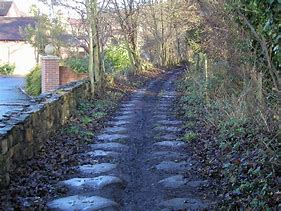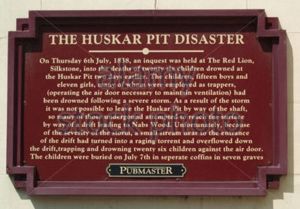- Profile
- Images
Location: Silkstone, Barnsley, South Yorkshire, England
Surnames/tags: Mining Disasters England Disasters
Worldwide Disasters | Mining Disasters | England Mining Disasters |Yorkshire Mining Disasters |Huskar Colliery, Silkstone, Yorkshire, 1838
Contact: Joan Whitaker
History and Circumstances
- Date: 4 July 1838
- Location: House Carr (Huskar) Colliery, Silkstone, Barnsley, Yorkshire, England
- Victims: 26 lives lost
- Cause: Coal Mine Inundation
- Mine History
Huskar Pit was a coal mine in the South Yorkshire Coalfield that was sunk to work the Silkstone coal seam. The mine was in Nabs Wood, outside the village of Silkstone Common, in the then West Riding of Yorkshire. The Huskar Colliery was joined to the Moorend Colliery for the purposes of ventilation and was the property of Mr. R.C. Clarke of Noblethorpe.
The official name of the coal mine was House Car Colliery. Huskar is local dialect.
The Silkstone coal seam is at its shallowest in the Silkstone area. Mining was an important local industry, not only in Silkstone, but in the surrounding area. Wikipedia gives good description of the South Yorkshire Coalfield.[1]
- Mine Disaster Circumstances
The 4th of July 1838 was a dreadful day in Silkstone's history. It was when 26 children between the ages of 7 and 17, working as 'hurriers' and 'trappers', were drowned at the local coal mine.

|
| The stream in Nabs Wood which caused the Flood |
On the day of the disaster there was a violent summer thunderstorm from about 2 p.m. to 4 p.m. Hailstones and about two to two and half inches of rain fell.
In 1838 Huskar was connected to nearby Moorend Colliery, and used for ventilation. The pit had a shaft used for pulling coal to the surface by a steam engine. There was also a drift shaft (known as a "dayhole") which passed through old workings and lead to nearby Nabs Wood. This was sometimes used as an unofficial exit from the pit by the miners.
That afternoon rain put out the boiler fire and the engine could not be use to take the miners to the surface. A message was sent down the pit for all the miners to make their way to the pit bottom. This they did, but those working underground were not aware of the reasons for the emergency.
A clap of thunder may have been mistaken for an explosion. Forty-four children were working below ground and, ignoring instructions to stay where they were, decided that, if there had been an explosion, there was quick and safe way out by way of a ventilation drift to Nabbs Wood.
At the bottom of the drift, there was an air door and the children went through this. As they made their way up the drift, a stream which was swollen into a rushing torrent by the downpour, overflowed down the drift. The children were washed off their feet and down to the door through which they had just passed. The water rose against the door and twenty six children were drowned. Some of the older children managed to escape along a narrow opening which lead to the Moorend Colliery to raise the alarm.
Twenty-six children died, their bodies thrown together near the door through which they had just passed. Joseph Garnett, the father of one of the children, was one who went in after the water had subsided and he found the body of his child. It could not be recovered until all the twenty six had been removed.
The children were taken to Thostle Hall where George Teasdale and a man named Buckley washed them and then they were taken to their homes in the village in carts.[2][3]
- Investigation Report
The inquest into the disaster was held on Thursday 6 July at the Red Lion Inn, Silkstone by Mr. Thomas Badger of Sheffield, Coroner. The bodies had been viewed at their homes,
Joseph Huskar, who lived in Huskar, told the court what happened on that fateful day. "Eleven of us were together and they all drowned but me. The water swam me down the day hole and through a slit into another board gate.
William Lamb said, "We did not know what we were going out for. We thought it was fire. The water washed the children down the day hole against a door, through which we had just come, and they were all drowned. If we had stopped at the pit bottom we should have been saved."
Uriah Jubb stated that "I was coming up the dayhole with Elizabeth Taylor and some other. We heard the water coming and me and Elizabeth Taylor got into a slot in the dayhole and we stopped there until we could get out. The water met the others as they were coming up and drove them against the door where they were drowned."
- The coroner, Mr Thomas Badger of Sheffield said "‘It is now my duty to inquire whether any negligence had been used or any act of criminality committed by the parties, whose duty it was to render every assistance in their power towards rescuing the children from their awful situation. From the inquiries that have been made, I believe that there was no reason to suppose that such was the case, or that any act of criminality has been committed; and if the jury is satisfied, after the hearing the evidence, that such was a fact, they will have no difficulty in returning a verdict of accidental death."
After hearing all the evidence and the accounts of survivors, the jury returned a verdict of "Accidental Death".[2]
The Legacy
The children's bodies were brought up from the pit and buried together in the churchyard of All Saint's Church, Silkstone. A memorial was erected bearing the names and ages of those who died. [4]

|
| The Huskar Memorial, Silkstone Church Yard |
Queen Victoria took an interest in the disaster and the loss of so many young lives in a pit was a factor in the setting up of the Royal Commission to enquire into women and children working in coal mines. Nationwide, the disaster shocked public opinion.
The resulting inquiry led to the 1842 Mines Act which sought to introduce some protection for child miners and meant that all girls and boys under the age of ten were prohibited from working underground.[5]
In 1988, the community of Silkstone Parish built another memorial in Nabs Wood, depicting two children at work underground. [4]
In 2008, to mark the disaster's 170th anniversary, the event and subsequent inquest were turned into a play by Sylvia le Breton and performed by the local Grass Roots theatre group in Silkstone church. [6]
A novel by Alan Gallop about the event's history was published in 2003 (Sutton Publishing Ltd.), entitled "Children of the Dark: Life and Death Underground in Victorian England".[7], and Peter Bond wrote and performed a song, "Act of God", about the tragedy; the song is included on the 1979 album "See Me Up, See Me Down" from Highway Records.[8]
In 2010, a commemorative stained glass window crafted by local residents was installed in the church.[9]

|
| Huskar Memorial Window, Silkstone Church |
Sources
- ↑ Wikipedia
- ↑ 2.0 2.1 Wayback Machine
- ↑ The Sheffield Independent 7 July 1838 Findmypast
- ↑ 4.0 4.1 Silkstone Reflects The Huskar Pit Disaster
- ↑ Mines and Collieries Act 1842
- ↑ Grass Roots Theatre Group.
- ↑ Children of the Dark Book (Amazon)
- ↑ See Me Up, See Me Down
- ↑ Silkstone Reflects The Huskar Disaster Window
Victims
|
|---|
- Login to edit this profile and add images.
- Private Messages: Contact the Profile Managers privately: Joan Whitaker and Disasters Project WikiTree. (Best when privacy is an issue.)
- Public Comments: Login to post. (Best for messages specifically directed to those editing this profile. Limit 20 per day.)






Joan
He was the son of Elizabeth (née Barraclough) and Joseph. They were married on 3rd February 1828. Samuel was born on the 14th July.
I will have a look at it when I have a bit of time. Joan